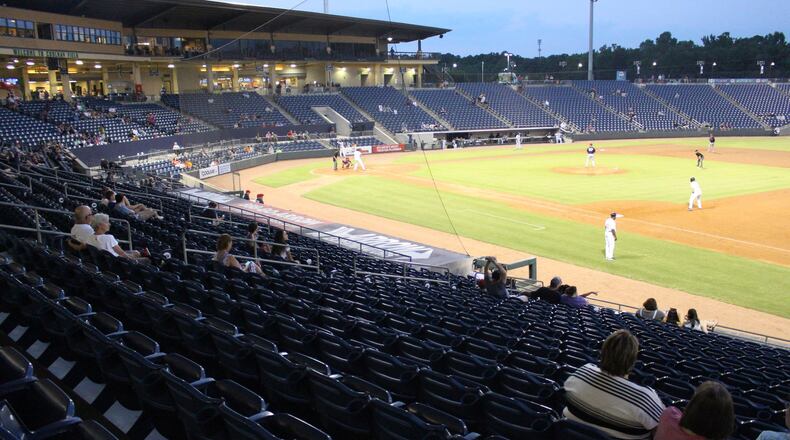Before this season began, Gwinnett County's minor league baseball team ditched its Braves surname and became the Stripers — an homage to the most bountiful breed of bass in Lake Lanier.
The thinking was that it would help differentiate the suburban squad from its major league counterpart playing in Cobb County. It would make marketing easier, stir up some new excitement and, potentially, give attendance at taxpayer-funded Coolray Field a much-needed bump in its tenth year.
But thus far, few fans have taken the bait.
Two games into the Stripers’ penultimate homestand, which started Monday, their average attendance was 3,114 — even lower than 2017’s season average and still dead last in the 14-team International League.
VIDEO: Previous coverage on this issue
Stripers general manager North Johnson said Monday there have been positives to his team’s new name.
Merchandise sales are expected to nearly double from what they were last year. The new logo and colors have been well-received, and marketing efforts have improved.
“The negative,” Johnson said, “is we haven’t seen the uptick in ticket sales that we thought we would see.”
He was sitting in the stands prior to a game where the announced attendance was a shade over 800. The actual crowd was much more sparse.
A longtime minor league executive, Johnson is still optimistic that another year or two might turn the tide for the Stripers, that more Gwinnettians (and others) will catch on and learn to love something that, with a unique name, can be more their own.
“We can’t figure it out, where the disconnect is,” longtime season ticket-holder Gina Smith said Monday, from her perch above right field. “It’s a great park, and they’re a Triple-A team, not a high school team. This is a big deal.”
It’s hard to say, definitively, what’s been behind Gwinnett’s decade-long attendance struggles. But some potential explanations are easier for Johnson and others to point to.
Lingering animosity
Animosity over the way Gwinnett earned a minor league baseball team still lingers in some.
The county made the deal with the Braves to relocate their Triple-A affiliate from Virginia without any public input, agreeing to cover the $64 million price tag of Coolray Field’s construction with taxpayer dollars. Officials hoped the stadium and its surrounding area would become a self-sustaining economic development powerhouse.
That hasn't happened and, even after a recent refinancing, the county will still pay around $2.1 million in debt service each year until 2038.
“I still run into people 10 years later who tell me they’re still mad that this place was built,” Johnson said. “And my response is, it’s here, you might as well enjoy it.”
At the moment, revenue from ticket sales doesn’t directly affect how much Johnson’s organization passes along to Gwinnett for the county’s payments — but it could.
The contract between the team and the county says the Stripers should pay Gwinnett $1 per ticket sold, with a “minimum annual guarantee” of $400,000. The team would have to nearly double its average yearly attendance to eclipse that mark and chip in more.
Little development nearby
The area surrounding Coolray Field was supposed to be The Battery Lite, a smaller predecessor of the mammoth mixed-use development that now surrounds the Atlanta Braves' stadium in Cobb County.
Thanks largely to the recession, that didn’t happen. There are now apartments overlooking the ballpark, but nothing in the way of entertainment options for fans.
County Commissioner Jace Brooks, whose District 1 includes Coolray Field, said that “the addition of restaurants and other entertainment and retail outlets immediately adjacent to the stadium could help” with attendance.
Johnson pointed to International League counterparts like the clubs in Charlotte and Indianapolis and Columbus, Ohio. They’re all in the middle of cities, he said, while the Stripers sit in the middle of unincorporated Gwinnett, surrounded mostly by woods.
Those other teams also don’t have big league clubs within a short drive.
The Big Braves
Johnson said he expected a bit of an attendance bump after the Atlanta Braves moved in 2017 from downtown Atlanta to Cobb County, which can present a more daunting trek for Gwinnettians. That hasn’t happened (perhaps because the major league team is, well, good).
The nearby presence of the “Big Braves” has also presented other problems.
“It feels like, and I don’t know why, but people aren’t coming here to watch those guys before they get to the big leagues,” Johnson said. “They’re just waiting for them to get to the big leagues. And that’s so different than any other team I’ve worked for.”
An inability to market properly was cited as a primary reason for changing the Gwinnett team’s name. Brooks, the county commissioner, has frequently criticized what he called a “consistent lack of marketing funds and initiatives from the parent organization.”
Johnson said he saw a “pretty significant increase” in the amount of marketing dollars at his disposal this year, but still described the total as “not substantial.” Still, the team was able to increase its presence on billboards and increase local radio and TV spots this season.
And while it may not have translated into attendance yet, Johnson said people are talking.
“We all would like to see higher attendance for the baseball games,” Gwinnett Commission Chairman Charlotte Nash said, “but we appreciate the efforts that the Gwinnett Stripers organization has put into marketing.”
Community competition
Marketing may in fact be more important than ever because the Stripers aren’t just competing against the big club, other sporting events or places like Stone Mountain, Lake Lanier and Six Flags to draw crowds anymore.
Johnson believes his club is now up against the growing number of cities and communities in Gwinnett County that hold regular — and often free — events at downtown squares or town lawns. That’s a trend that largely started after minor league baseball’s arrival in Gwinnett and has only accelerated in recent years.
Gwinnett has more than a dozen cities.
“You always play the ‘what if that had been built,’ what if the economy hadn’t tanked, what if [during] the first year things had been run a little better on the management side?” Johnson said. “… But you know, let’s play the cards we’re dealt.”
Gwinnett Stripers average home game attendance
The 2018 season is the team’s first since changing its name from the Gwinnett Braves to the Gwinnett Stripers. Coolray Field has more than 10,000 seats.
2018 (through Aug. 14): 3,114*
2017: 3,135*
2016: 3,218*
2015: 3,808**
2014: 4,281**
2013: 4,762**
*Worst in 14-team International League
**Second-worst in 14-team International League
About the Author
Keep Reading
The Latest
Featured








